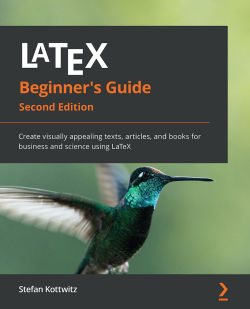In the TeX world, the name Stefan Kottwitz is best known for the websites and forums he runs, but Stefan is not just a server admin but also a book author. The first edition of his LaTeX beginners book was published in 2011, followed by the “LaTeX Cookbook” in 2015, now the second edition of the beginners book “LaTeX Beginners Guide” is available.
The book is published by Packt, who kindly provided me with a copy of the book. As I had to prepare several LaTeX courses I was eager to have a closer look at it.
On a little more than 300 pages Stefan introduces the different aspects of LaTeX. On 25 pages the history of TeX and LaTeX is briefly outlined as well as the installation of TeX Live and the use of Overleaf. The second chapter is on how to format text. I like that this chapter already shows how to create your own commands as I also do this in my courses to show the participants how easy it is to use more complex markup with self-defined commands.
Chapter 3 shows how to set page formats and type area, followed by an explanation of the various list types in Chapter 4. Chapters 5 and 6 describe the typesetting of figures and tables, respectively, followed by cross-references in Chapter 7.
Chapter 8 shows how to customize tables of contents and create an index. In addition, Stefan discusses typesetting bibliographies with the standard bibliography environment and BibTeX in this chapter. BibLaTeX is unfortunately left out at this point, but Stefan describes it in his LaTeX Cookbook.
Chapter 9 is devoted to mathematics, covering all the constructs a student might encounter even in a STEM subject. Chapter 10 goes into the various fonts that can be used in pdfLaTeX, and also shows how any system fonts can be used with xeLaTeX or luaLaTeX. Chapter 11 shows in detail how to split longer documents into separate parts with \input and \include.
Chapter 13 is highly relevant especially for LaTeX newbies, as it shows how to narrow down and fix problems in case of errors.
 The book ends with a detailed description of web forums and sites where one can get support and also introduces user groups like TUG and Dante e.V.. The website for the book can be found at latexguide.org. There you can find the FAQ for the book as well as the source code with online compilation.
The book ends with a detailed description of web forums and sites where one can get support and also introduces user groups like TUG and Dante e.V.. The website for the book can be found at latexguide.org. There you can find the FAQ for the book as well as the source code with online compilation.
In summary I can say that I liked the book of Stefan very much and I will recommend it also in my courses. Together with the LaTeX Cookbook, which describes not only Biblatex but also the creation of graphics using LaTeX, it offers a good introduction to LaTeX.


